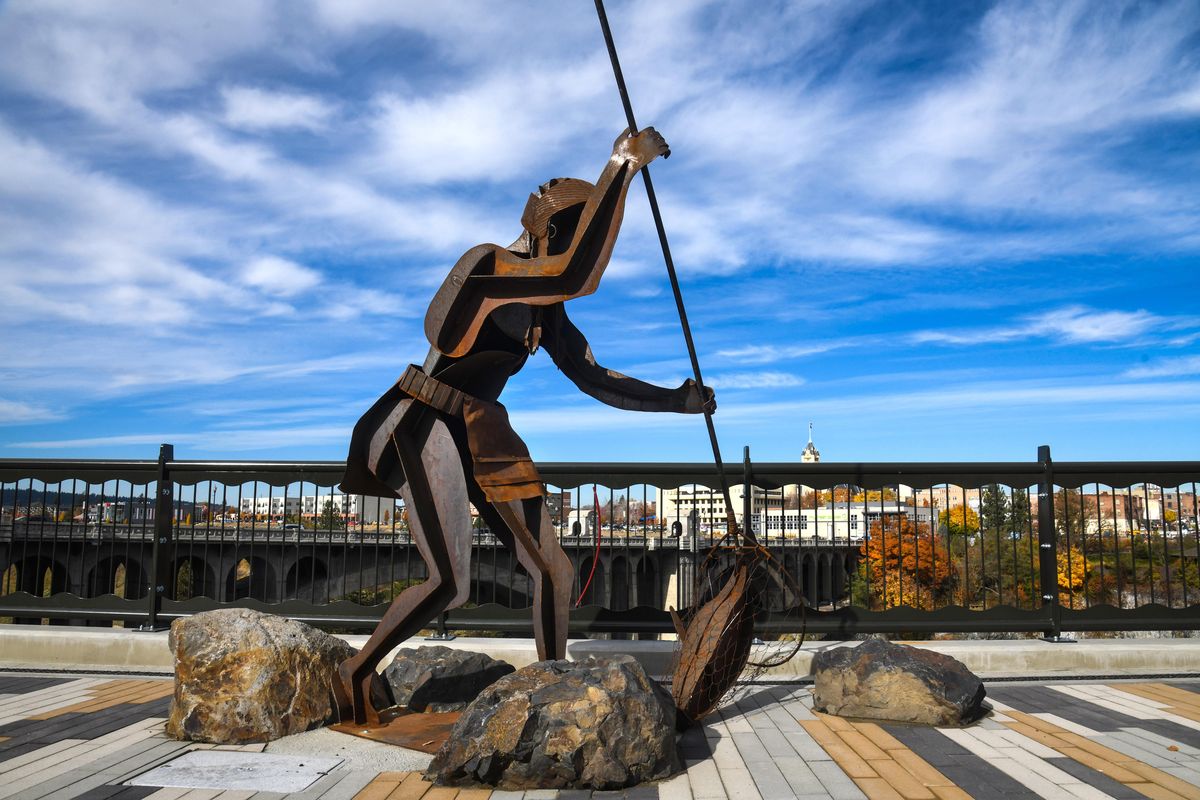‘A Place of Truths’: New downtown plaza teaches Spokane tribal history, river preservation

A one-and-half-times life-size metal fisherperson towered over 3-year-old Matilda Salisbury as she explored the A Place of Truths Plaza downtown for the first time and looked out over Spokane Falls.
“We’re excited to have this open up the river and have another place to look at it,” said her mother, Katie Salisbury. “She’s been watching the construction for the past year” from the downtown library.
The larger-than-life statues, and the plaza they sit on, that debuted to the public Friday afternoon were crafted by Smoker Marchand, a member of the Colville Tribes, to serve as a reminder of Spokane’s indigenous heritage and the importance of preserving the river running through it.
“You’re standing on our ancestral territorial grounds that are so significant to not only the Spokane Tribe, but to all the interior Salish tribes that would come and fish these falls,” Jeff Ferguson, a Spokane Tribe member and the project’s lead artist, told the crowd gathered for the plaza’s opening.
Beneath the plaza sits the functional environmental piece of the $25 million project, a 2.2 million-gallon tank sitting underneath the plaza that will keep wastewater, like storm and snow runoff, from draining into the river before it can be treated.
“If you think about how significant this is, it’s to save our river,” Ferguson said. “The river is our lifeline.”
When the first merchants came to Spokane in 1857, they saw 300 Spokane Tribe members near where the Rotary Fountain in Riverfront Park is today, Ferguson said. It was the biggest fishing village in 100 miles.
The Spokane Tribe used to catch an average of 1,000 salmon at the Spokane Falls during its 100-day fishing season each year, Ferguson said. Most salmon were around 30 pounds, and some got as large as 110 pounds and five feet long.

Those fish are the same size as the the ones being caught by the statues in the plaza. One metal person spears a fish with a trident, another catches one in a net, and a third uses a basket trap, just like tribal members used to. A woman holds two handfuls of eels, which were a delicacy and produced oil worth more than gold, Ferguson said.
But all of that changed when construction of the Grand Coulee Dam in the 1930s began blocking fish from traveling to the upper Columbia River, Ferguson said. The Spokane Tribe’s largest source of food and trade was effectively gone.
Ferguson said he pushed for the plaza to be named A Place of Truths because of the lack of education about Spokane’s indigenous people before and after white settlers came. There was a single line about the Spokane Tribe in his middle school history book when he went through school in the area, Ferguson said. The name is given in Salish as well as English on interpretive signs.
Metal animal statues at the plaza represent a Salish creation myth. At the west end of the plaza, Sherman Alexie’s poem “That Place Where Ghosts of Salmon Jump” is etched into a granite spiral first installed with the construction of the library in 1995.
And in two more weeks Ferguson hopes to print out and mount a collage of photos symbolizing the past, present and future of the Spokane Tribe on a wall of one of the wastewater facility buildings.
Portraits of Spokane Tribe ancestors, like Chief Three Mountain, Alex Sherwood, Sam Boyd and Sadie Boyd, will fill one 8-foot-by-4-foot panel above a photo of 88 tepees on Glover Field from the Northwest Indian Congress that brought 3,000 tribal members to the area in 1925.
Other panels will depict present-day Spokane Tribe members and children, the solar panel farms being installed near Wellpinit and the effects of the Grand Coulee Dam on tribal life.
“We’re connecting to the river in new ways again today, and we know that the more we connect with the river, the more we will protect it for the future,” Mayor David Condon told people at the grand opening.
City Council President Ben Stuckart thanked the Spokane Tribe for its ongoing partnership.
“We recognize and celebrate tribal sovereignty and seek to preserve the Spokane River as a place where residents and visitors can remember and reflect on the heritage, culture and history of our community,” Stuckart said.
The plaza will be open to the public during daytime hours on Saturday and Sunday before it closes for final construction.
“The whole parks system down here is phenomenal,” said Dianna Cline, who has lived in Spokane for 73 years and biked to the plaza opening. “I remember when it looked nothing like this.”
This article was updated to correct the spelling of Sadie Boyd’s name.